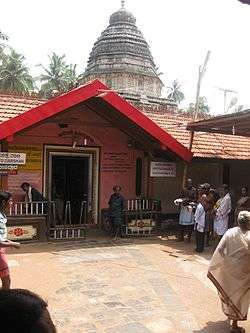Mahabaleshwar Temple, Gokarna
| Mahabaleshwar Temple | |
|---|---|
|
Mahabaleshwar Temple at Gokarna | |
 Mahabaleshwar Temple Location within Karnataka | |
| Name | |
| Proper name | Mahabaleshwar Temple, Gokarna |
| Geography | |
| Coordinates | 14°32′36″N 74°18′59″E / 14.54333°N 74.31639°ECoordinates: 14°32′36″N 74°18′59″E / 14.54333°N 74.31639°E |
| Country | India |
| State | Karnataka |
| District | Uttara Kannada District |
| Locale | Gokarna |
| Culture | |
| Primary deity | Lord Shiva |
| Important festivals | Shivaratri Rathyatra |
| Architecture | |
| Architectural styles | Dravidian architecture |
| History and governance | |
| Date built | 345 - 365 CE |
| Creator | Mayuravarma of Kadamba |
The Mahabaleshwar Temple, Gokarna is a Hindu temple located in Gokarna, which is a Hindu religious pilgrimage centre in Uttara Kannada district in the Indian state of Karnataka. A Pranalinga (Pranalinga is defined as “the reality of God which can be apprehended by the mind.”[1]) also known as Atmalinga or Shiva Linga is deified in the temple, which is facing the city beach of the Arabian Sea in Gokarna. The Shiva Linga has a hoary legend. It is said to bestow immense blessings to devotees who even glimpse it.[2][3] The temple is considered as pious as the Shiva temple at Varanasi or Kashi in North India on the banks of the Ganges River and hence is known as the Dakshin Kasi (South Kasi).[2][3]
The temple, built in a classical Dravidian style of architecture, was first constructed by Mayurasharma of the Kadamba dynasty, who ruled between 345 – 365. This king wanted to gain knowledge of the Vedic rites and the Ashwamedha Yagna (a horse sacrificial ritual), so he travelled to Kanchipuram, a major learning centre, but on reaching there, was insulted by a horseman guard and angry, he swore to defeat the Pallava dynasty (the then ruling dynasty). Following their defeat, the king asked a few priests to perform a daily yagna to maintain his suzerainty over the region. His son, King Kangavarman brought more Brahmin families from different lineages to maintain administration at the temple. Kalidasa mentions the "Lord of Gokarna" in his Raghuvamsha of the 4th century. The Gokarnam shrine is one of the Paadal Petra Sthalams of the 7th century Tevaram canon. Visvesvaraya of Halasunadu-Kundapura built the Chandrasala and Nandi pavilions when Queen Chennammaji and her son Soma sekharanayaka were ruling Keladi (1653-1671). The temple is a large complex of shrines and much of it belongs to the later Vijayanagara period. In 1665, Shivaji came here to worship the deity.
According to the legend, the Atmalinga was perforce placed at Gokarna, in the temple precincts where it is now deified, by Ravana, the demon King of Lanka of epic Ramayana fame when he carried it from Mount Kailash in the Himalayas. Pilgrims take a holy dip in the Arabian Sea before visiting the temple for worship.[2][3][4] It is one of the seven sacred Muktikshetras or Mukthistala (place of salvation) in India where many Hindus of Karnataka perform obsequies (death rites) for their departed; six other Muktistalas in Karnataka are: Udupi, Kollur, Subrahmanya, Kumbasi, Koteshvara and Sankaranarayana.[5][6]
Geography
The temple is located on the shores of the Karwar coast of the Arabian Sea in a green environment in the holy town of Gokarna, also spelt Gokarn, on the West Coast of India in Uttara Kannada or North Kannada district. Gokarna lies between the Gangavali and Aganashini rivers.[3][7]
National Highway 17 (NH17), a coastal highway on the western ghats of India (from Mangalore to Mumbai), passes close to the temple town of Gokarna. The town is 56 kilometres (35 mi) from Karwar and 252 kilometres (157 mi) from Mangalore on this highway.and town is 145 kilometres (90 mi) from Hubli. It is 450 kilometres (280 mi) from Bangalore and the nearest airport is at Panaji, Goa, 155 kilometres (96 mi) away.[3][7]
Legend
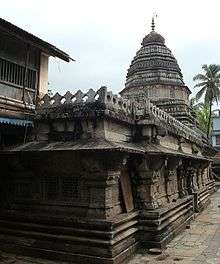
The hoary legend of the temple as narrated links Ravana of Ramayana fame, the demon king of Lanka, not only to the Shiva Linga deified in the Mahabaleshwar Temple but also to the Bhadra Kali temple here. The legend also provides the reasoning for the naming of the Gokarna town.[4]
Ravana's mother, a staunch devotee of Lord Shiva, was worshipping a Shiva Linga to bring prosperity to her son. Indra, the Lord of Heaven, who was jealous of this worship, stole the Shiva Linga and threw it away into the Sea. The distraught mother of Ravana went on a hunger strike as her devotional worship of Shiva was disrupted. Ravana then promised his mother that he would go to Mount Kailash, the abode of Lord Shiva, and bring the main Atmalinga itself for her worship. Ravana then performed severe penance at Mount Kailash to please Lord Shiva and also sang, in his melodious voice, praises of Shiva (Shiva Tandava Stotram). He even chopped his own head, and made a harp with threads drawn from his skin and intestine. Shiva pleased with all this devotional worship agreed to bestow boons to Ravana. Ravana, pleased with the promise of Shiva, asked for the Atmalinga and also a wife for himself, as pretty as Uma (mother of creation), Shiva's wife. Shiva then took out the Atma Linga, brightly shining like the Sun, from his own heart and gave it to Ravana with strict instructions that it should not be placed on ground till it was deified at a final destination. As regards the second request for a beautiful wife, Shiva offered his own wife to Ravana, as in his view there was no other woman more beautiful than Uma, his wife.Uma, who was ordered by Shiva to go with Ravana, then appealed to Lord Vishnu for help. Vishnu agreed and he met Ravana at Gokarna, disguised as an aged, frail looking Brahmin. The Brahmin asked Ravana as to how such a lovely woman was following him. Ravana, in his enthusiasm, explained that Shiva of Kailash himself had given her to him. Pleased with the Brahmin's words of praise, . This was his undoing as at that moment, Vishnu played a trick and exchanged Uma with mandodari daughter of mayasura,
Ravana returned carrying the Atmalinga. On the way, he met Ganesha in the garb of a cowherd (by the request of lord indra) at the same location where he had deserted Uma. At that moment Ravana wanted urgently to attend the call of nature and he, therefore, requested Ganesha to hold the Atmalinga in his hand till he returned after ablutions.[8] There is another version to the legend at this point. It is said that Ravana, being a Brahmin wanted to offer his evening religious prayers, Sandhyavandanam, and he, therefore, requested Ganesha, who appeared before him as a Brahmin boy, to hold on to the Atmalinga till he returned; with strict instructions to Ganesha not to place it on the ground under any circumstance.[6]
However, Ravana could not come within the specified time. Ganesha called out thrice rapidly for Ravana. Even before Ravana could return, Ganesha placed the Atmalinga on the ground, tricked Ravana and vanished from the scene with his cows. Ravana then chased the only cow, which was going underground. However, he managed to get hold of the cow's ear only, as the rest of cow's body had disappeared below ground. It is this ear now seen in a petrified form, which has given the name 'Gokarna' to the place, meaning "Cow's ear." (in Sanskrit 'Gow' means "cow" and 'karna' means "ear").[6][9][8] Then, Ravana tried hard to lift the Shiv Linga but failed as it was firmly fixed. Ravana had even fainted; thereafter he gave the name Mahabaleshwar (meaning all-powerful) to the Atmalinga.[9] Thus, according to the legend narrated, the place now boasts of three divine entities namely: Gokarna, the cow's ear; the Atmalinga or Shiva Linga that is deified in the Mahabaleshwar Temple; and the Goddess Bhadrakali, which are all now divine places of worship integral to Gokarna.[10]
Temple structure
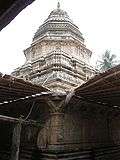
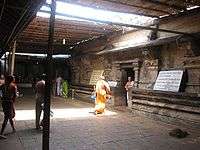
The temple built in Dravidian architectural style, with granite stones, has the Atmalinga enshrined in it on a "square Saligrama Peetha" (pedestal). It has a small hole at its centre from where devotees can see the top of the Atmalinga. The deity, a carved stone image of Lord Shiva, is also deified here in a standing position and has two arms, and is said to be 1500 years old.[6][7][9]
Historical
Vijayanagara Emperor visited the temple and weighed himself in gold here. In 1665, Shivaji, after disbanding his army here, worshipped at the temple. In 1676, Fryer, the English traveller visited the place during Shivaratri festival and has written in detail about the festival at the temple.[11]
Religious practices
The religious practices observed by most devotees, who are accompanied by their priests, consists of first shaving their head, fasting and taking a bath in the Arabian Sea, opposite to the temple. Then, they pay obeisance to lord Ganesha (the elephant headed god) defied in the Shri Maha Ganapathi Temple, which is a few yards away from the Mahabaleshwar Temple. After observing all these religious procedures, devotees visit the main shrine of Mahabaleshwar for a darshan, with the fervent prayer that such a formal viewing of god would wash all their sins and usher prosperity in their lives.[12]
- Festival
Shivaratri festival, observance of the union of Lord Shiva and Goddess Parvati is celebrated in the temple town in February, when a very large number of pilgrims visit the shrine. During this festival, Rathyatra (Rath is a large wooden chariot) is also held when images of Shiva and other deities are installed in the chariot and it is then ceremonially pulled through the town by devotees, accompanied by the drum bands. The Rathayatra starts from the Shri Maha Ganapati Temple at the terminus of the main market street, also known as the 'Car Street'.[5][7][12]
Other attractions
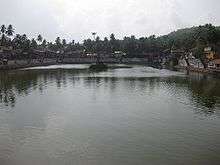
Apart from the Mahabaleshwar Temple there are several other attractions of religious significance in Gokarna that are linked to the local legend of the temple. These are:[6]
- Sri Maha Ganapathi temple
According to the legend Sri Maha Ganapathi Temple was built in honour of the boy Ganapathi, who deceived the demon Ravana and saved the Atmalinga that is now installed in the Mahabaleshwar Temple. The temple has a granite image of Ganesha deified in it which is 5 feet (1.5 m) tall and two-handed; at the top of its head there is hole that is stated to be a mark of a violent blow conjectured to have been inflicted by Ravana. The temple has its own identity and is also known as Sidda Ganapati.[13][14]
- Gogarbha
According to legends, the Atmalinga that vanished in the form of gov or cow made a lasting cave in the nearby hill called as "Gogarbha" meaning 'the woumb of cow'. The cave is still visited by sadhus and used as a resting place. The folklore said sadhus went into 'Gogarbha' and reached 'Kashi', the holy city of hinduism and final pilgrim place to visit.
- The Temple of Bharat
Although one of a kind temple still exists on the hillock near the mahabaleshwar temple, its deity has been stolen by miscreants. Its uniqueness is that it is situated well above the temple of Rama with a ramateertha
- Kotitheertha
Kotitheertha is a man-made pond, which is used for immersion of idols and ritual bathing. It is surrounded by temples and has a small platform in the centre.[15] Devotees usually take bath in the pond before they visit the Mahabaleshwar Temple for worship.[16]
External links
References
| Wikimedia Commons has media related to Mahabaleshwar Temple, Gokarna. |
- ↑ Subramuniyaswami, Satguru Sivaya (2003). Dancing With Siva: Hinduism's Contemporary Catechism. Himalayan Academy Publications. p. 847. ISBN 0-945497-96-2. Retrieved 2010-05-28.
- 1 2 3 Abram, David (2003). Rough Guides Rough guide to Goa Check
|url=value (help). Gokarn. pp. 234–237. ISBN 1-84353-081-3. Retrieved 2010-05-27. - 1 2 3 4 5 Various. Tourist Guide to Karnataka. Uttara Kannada. Sura Books. pp. 61–62. ISBN 81-7478-062-9. Retrieved 2010-05-27.
- 1 2 Gupte, B.A. (1994). Hindu holidays and ceremonials: with dissertations on origin folklore and symbols. Bhdra kali. Asian Educational Services. pp. 13–16. ISBN 81-206-0953-0. Retrieved 2010-05-27.
- 1 2 "Gokarna: A Profile". Sri Gokarna Web site of Temple Administration. Retrieved 2010-05-27.
- 1 2 3 4 5 "Gokarna". Karnataka Vision. Retrieved 2010-05-27.
- 1 2 3 4 "How to reach Gokarna". Sri Gokarna Web site of Temple Administration. Retrieved 2010-05-27.
- 1 2 Gupte, p.15
- 1 2 3 Padmanabha, P. (1973). District Census Handbook, Series 14, Mysore: North Kanara. Govt. Press, for India (Republic). Office of the Director of Census Operations. p. 142. Retrieved 2010-05-28.
- ↑ Gupte, p.16
- ↑ Gazetteer of the Bombay Presidency, Volume 15, Part 2. Govt. Central Press. 1883. p. 299. Retrieved 2010-05-28.
- 1 2 Abram, p.260
- ↑ "Famos Ganesha temples". Retrieved 2010-05-28.
- ↑ Bezbaruah, Madan Prasad; Dr. Krishna Gopa (2003). Fairs and Festivals of India: Andhra Pradesh, Karnataka. Gyan Pub. House.
- ↑ "The Bhandikeri Math at Gokarna". Shri Chitrapur Math. Retrieved 2010-05-28.
- ↑ "Karwar Taluk". Kumpta Taluk: Gokarna. national Informatics Centre. Retrieved 2010-05-28.
